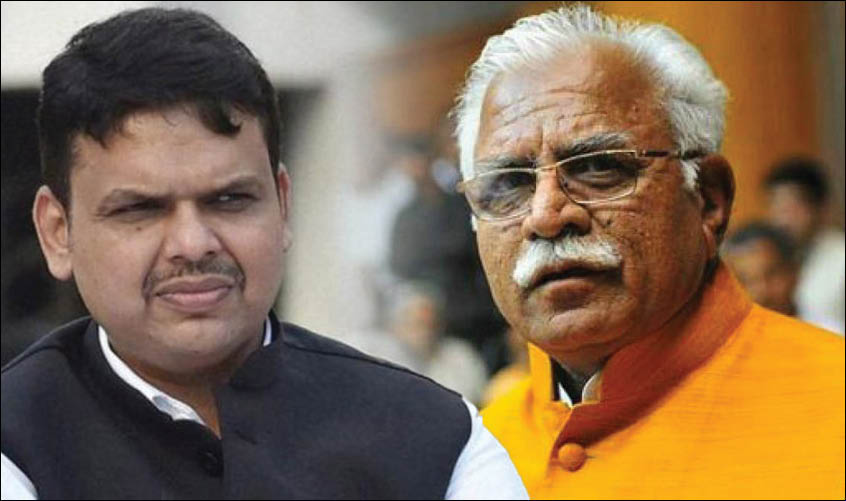NEW DELHI: The recently concluded elections to the Maharashtra and Haryana Assemblies have beyond any doubt established that political parties need to reinvent their strategies, keeping in view the ground realities that exist. The BJP may have been able to retain power in both the states but it has to realise that hyper-nationalism and anti-Pakistan sentiments were not sufficient reasons any longer to win the day for them. Their primary leaders need to shift their attention to core governance issues by initiating immediate measures to improve the economic crisis, since the steps taken so far have proved to be inadequate.
On the other hand, firstly the Congress has to rid itself of its casual and laidback approach towards politics and entrust the task to strong regional leaders so as to enable it perform in a fitter manner. The important point to note is that the Gandhis were fast losing their relevance, and if the party has done fairly well in Haryana, it is solely because former Chief Minister, Bhupinder Singh Hooda was able to galvanise the cadres to take on the BJP. The Congress could have formed the government in the state had the high command given more time to Hooda to revive its prospects, and allowed him a greater say in the ticket distribution.
In Maharashtra, the grand old party virtually appeared to be a reluctant participant with none of its front-ranking leaders whole-heartedly joining the campaign trail. In sharp contrast, the NCP led by Sharad Pawar put up a valiant fight in all areas, therefore succeeding in sending out a strong message of its intention. In the Satara Lok Sabha byelection, where Chhatrapati Shivaji’s descendant Udayanraje Bhonsale contested on the BJP ticket to lure the Marathas towards the saffron brigade, Pawar stood his ground and ensured that he was defeated. Satara after all was the constituency of Pawar’s mentor, the late Yashwant Rao Chavan, and the veteran leader saw to it that the BJP’s juggernaut was halted there.
The Haryana outcome had several similarities with the result in 2009 when the Congress was able to secure only 40 seats, with Kuldeep Bishnoi’s regional party winning six, besides the seven independents who won. This time around, the BJP has 40 seats, the JJP, 10 and there are seven Independents again. However, the difference between then and now was that the contest in the state had at one level been reduced to Jats versus non-Jats. The majority of the Jats voted against the BJP, which if Manohar Lal Khattar had not been the Chief Minister, would have been reduced to a mere 15 or 16 seats. The Punjabi community, in particular, stood firmly behind the Chief Minister and thus successfully insulated the party from the aggressive inroads being made by the Jats. However, in the end, the JJP, essentially a Jat dominated party led by Chaudhury Devi Lal’s great grandson, Dushyant Chautala, decided to join hands with the BJP, thus lending the government greater stability. The story could have been different had some of the Congress heavyweights managed to hold on to their seats.
Ironically, everyone appears to be happy in Haryana. The BJP is ecstatic that it has been able to retain power. The Congress is content that it has done better than anyone had expected it to do, and in the process, ended up doubling its seats from 15 in 2014 to 31 in 2019. Dushyant is satisfied that in less than a year, he has been able to become a major player in the state and his party has virtually played the role of a kingmaker. The Independents are pleased that some of them may get accommodated in the new ministry. The Hoodas are assuaged that they have emerged as the most potent force within the Congress. The party cadres are at peace that all was not lost for them and if a leader like Hooda was at helm of affairs, political objectives could be achieved. And finally, Khattar is relieved that he has been given another term by the Prime Minister to head the difficult state.
In Maharashtra, Devendra Fadnavis is likely to face more problems than he can anticipate. Although the BJP leadership has made it amply clear to its ally, the Shiv Sena, that the Chief Minister’s position was non-negotiable, yet the Sainiks continue to make a strong pitch for Aaditya Thackeray, the first member of the Thackeray clan to contest an election. Aaditya is young and bright, and his party wants him to lead the state government, if one goes by the posters plastered all over Mumbai. The Shiv Sena chief, Uddhav Thackeray, has already advocated that his party wants a 50:50 power sharing arrangement in Maharashtra. This effectively means that the CM’s chair should be rotational with two and half years given to each of the two partners.
Politics is in full play in the state and Sharad Pawar, the old and experienced war house could still have a trick or two up his sleeve. He is closely watching the developments and as a consequence could play an imperative and authoritative role in determining the direction of politics. The BJP in Maharashtra has suffered losses just as it did in Haryana, thereby failing to reach its projected target. This background has paved way for the Shiv Sena to become more ambitious.
The BJP’s central leadership is seized of the challenges which have cropped up following the two elections, and is expected to factor in new elements in its future strategy. For the Congress, the better course would be to look beyond the Gandhis, since their significance in electoral politics is fast decreasing. It is time for them to ponder over politics minus the Gandhis, preferably a strong regional leader such as Hooda or Amarinder to head the Central party. The last word on this subject is yet to be heard.

